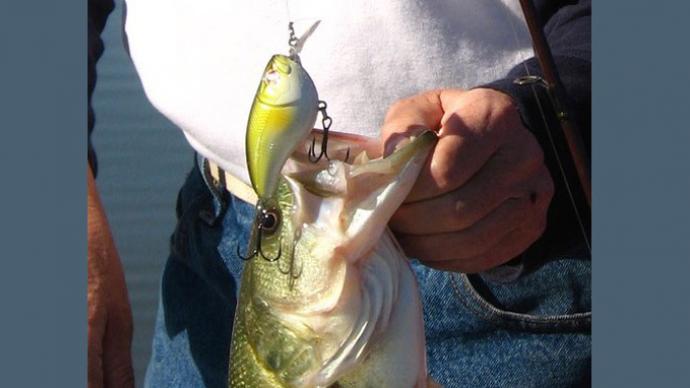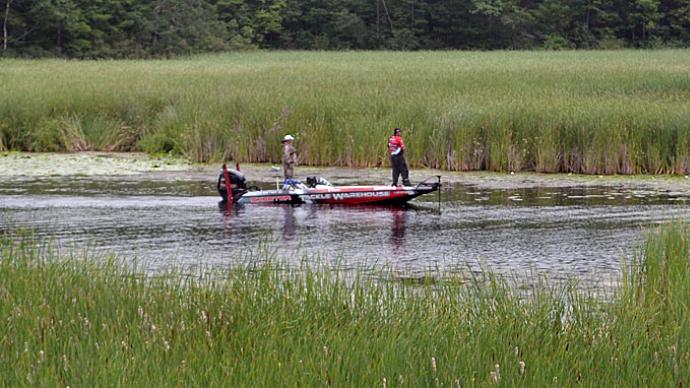1. What is Largemouth Bass Virus?
It is one of more than 100 naturally occurring viruses that affect fish but not warm-blooded animals. Origin is unknown, but it is of the Family Iridovirus and the Genus Ranavirus, related to a virus found in frogs and other amphibians and nearly identical to a virus isolated in some fish imported to the U.S. for the aquarium trade. Although the virus apparently can be carried by other fish species, to date, it has produced disease only in largemouth bass. Scientists do not know how the virus is transmitted or how it is activated into disease. In addition, they know of no cure or preventative, as is commonly the case with most viruses.
LMBV first gained attention in 1995, when it was implicated in a fish kill on Santee-Cooper Reservoir in South Carolina. Since then, the virus has been found in impoundments throughout the Southeast and as far west as Texas. Often, it has been confirmed in bass that show no signs of disease, which suggests that some fish might be infected but not ever become ill.
Some fish kills, however, have been linked to LMBV. Since all those die-offs occurred from June through September, warm-water temperatures might be a factor. No other common variables seem to exist among lakes where kills occurred. Some lakes, for example, contain aquatic vegetation and others do not, suggesting that neither plant density nor plant management triggered the disease to turn fatal.
Some scientists believe that "stressed" bass might be the most likely to die of the disease. Along with hot weather, stress factors might include poor water quality caused by pollution and frequent handling by anglers.
Thus far, LMBV-related kills have been minor in comparison to kills prompted by other causes, such as poor water quality or pollution. These LMBV incidents have received considerable attention, however, because they involve the nation's most popular game fish. Thus far, no evidence exists that LMBV has caused a long-term problem on any fishery or will have a long-term impact.
2. What are the signs of Largemouth Bass Virus?
Most bass that carry the LMBV will appear completely normal. In those cases where the virus has triggered disease, however, dying fish will be near the surface and have trouble swimming and remaining upright. That's because LMBV appears to attack the swim bladder, causing bass to lose their capability to maintain buoyancy. Diseased fish might also appear bloated. Adult bass of two pounds and more seem to be the most susceptible to disease. Sores may appear on some fish but are caused by secondary infections of bacteria or fungi.
3. Is Largemouth Bass Virus a new disease?
No one knows. Because LMBV has been confirmed in so many places at nearly the same time, some scientists suspect the virus has been around for awhile. Others suggest that "genetic sequencing information" indicates that it may be relatively new.
4. Where has Largemouth Bass Virus been found?
Since 1995, LMBV has been found in 15 states: Alabama, Arkansas, Florida, Georgia, Indiana, Kentucky, Louisiana, Michigan, Missouri, Mississippi, North Carolina, Oklahoma, South Carolina, Tennessee, and Texas. Other states, including Maryland and Virginia, have monitored for the virus, but did not find it. Others plan to do so in 2001. Between March and November 2000, researchers examined 3,476 largemouth bass and related sunfish species in nine southeastern states, according to the federal Warm Springs Fish Health Center. Of those, 464, or 13 percent, tested positive for LMBV.
Fish kills attributable to LMBV have been confirmed in nearly 20 locations. During 2000, fish died in Arkansas' Monticello, as well as Louisiana's False River and Oklahoma's Grand, Tenkiller, Hudson and Fort Gibson lakes. Kills also have occurred at Santee-Cooper, S.C. (1995); W.F. George Reservoir (also known as Lake Eufaula), Ala. and Ga. (1998); Greenwood Reservoir, S.C. (1998); Sardis Reservoir, Miss. (1998); Sam Rayburn, Texas (1998); Lake Fork and Lake Conroe, Texas (1999); Toledo Bend, Texas and La. (1999); Table Rock Lake, Mo. and Ark. (1999); Lake Ferguson and Tunica Cutoff, Miss. (1999), and Atchafalaya Basin, La. (1999).
5. What are the impacts to bass populations?
Scientists do not know enough yet about the virus to determine if it will have long-lasting effects on bass populations. Indications are, however, that it will not harm fisheries long term. Surveys on lakes following a kill suggest that fish populations remain within the normal range of sampling variability.
6. What are the impacts to fishing?
Following some kills, anglers have reported catching fewer bass, especially bigger fish. But indications are that an infected fishery will recover within a year or two. More largemouth bass are killed annually in the U. S. by other known diseases than by LMBV.
7. Are other fish and animals affected by Largemouth Bass Virus?
LMBV is a virus of the type that affects only cold-blooded animals. Researchers have found it in other bass and sunfish species, and even in trout, but, thus far, it has proven to be a fatal disease only for largemouth bass. Other members of the sunfish family found infected with the virus include smallmouth bass, spotted bass, Suwanee bass, bluegill, redbreast sunfish, white crappie, and black crappie.
Amphibians, reptiles, and other fish species could be carriers of LMBV. Scientists have found LMBV to be 98 percent identical to a virus found in guppies and "doctor fish," a freshwater aquarium species imported from southeast Asia. This suggests that LMBV could have originated with importation of an exotic species.
8. Are infected fish safe to handle and eat?
Yes. LMBV is not known to infect any warm-blooded animals, including humans. But common sense should prevail at all times: Thoroughly cook fish that you intend to eat. Also, fish that are dead or dying should not be used for human food, regardless of the cause of the illness.
9. What can and is being done?
As with many fish viruses, little is known about LMBV. But because of the popularity of largemouth bass, state and federal agencies, universities, and private interest groups are working hard to learn more about the virus and its impact on the resource. Universities involved with LMBV include Arkansas-Pine Bluff, Auburn, California-Davis, Louisiana State, Mississippi, Mississippi State, and Texas A&M. B.A.S.S. has sponsored and chaired meetings in 2000 and 2001 to bring all the managers and researchers together. This will be repeated in 2002.
10. What the experts think
Because so little is known about LMBV, scientists have few conclusions to offer regarding the virus. They do suggest, though, that LMBV probably will become an enduring element in ecosystems and a component in natural selection. In other words, it could serve as a population control. On the positive side, thus far there is no evidence that LMBV has the potential to cause anything more than sporadic fish kills.
11. What anglers can do
Anglers can help minimize the spread of LMBV virus and its activation into a lethal disease by doing the following:
- Drain all water from the bilge and livewells and clean boats, trailers, and other equipment thoroughly between fishing trips to keep from transporting LMBV--- as well as other undesirable pathogens and organisms---from one water body to another. Recent research has determined that the virus can live for several hours in water, confirming the importance of this practice.
- Do not move fish or fish parts from one body of water to another. And do not release live bait into a fishery.
- Handle bass as quickly and gently a possible if you intend to release them.
- Stage tournaments during cooler weather, so fish caught will not be so stressed.
- Report dead or dying fish to state wildlife agencies.
- Volunteer to help agencies collect bass for LMBV monitoring where appropriate.
- Educate other anglers about LMBV.
12. For more information on LMBV
Contact the fisheries office of your state Conservation Department (Call the B.A.S.S. Conservation Department at (334)272-9530 or write via e-mail to conservation@bassmaster.com if you need contact information for your state fishery agency).



